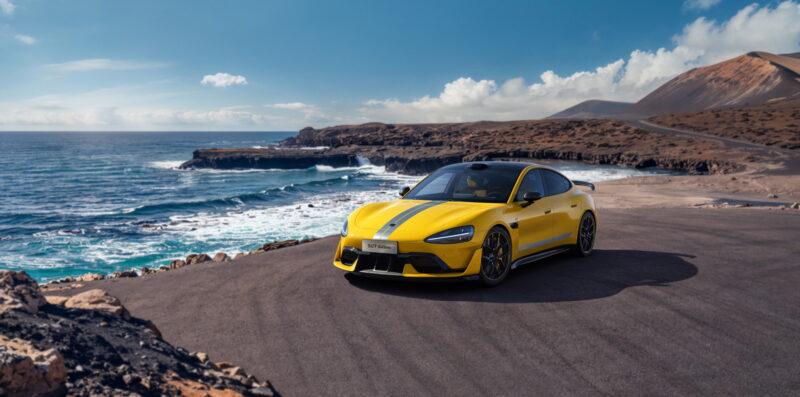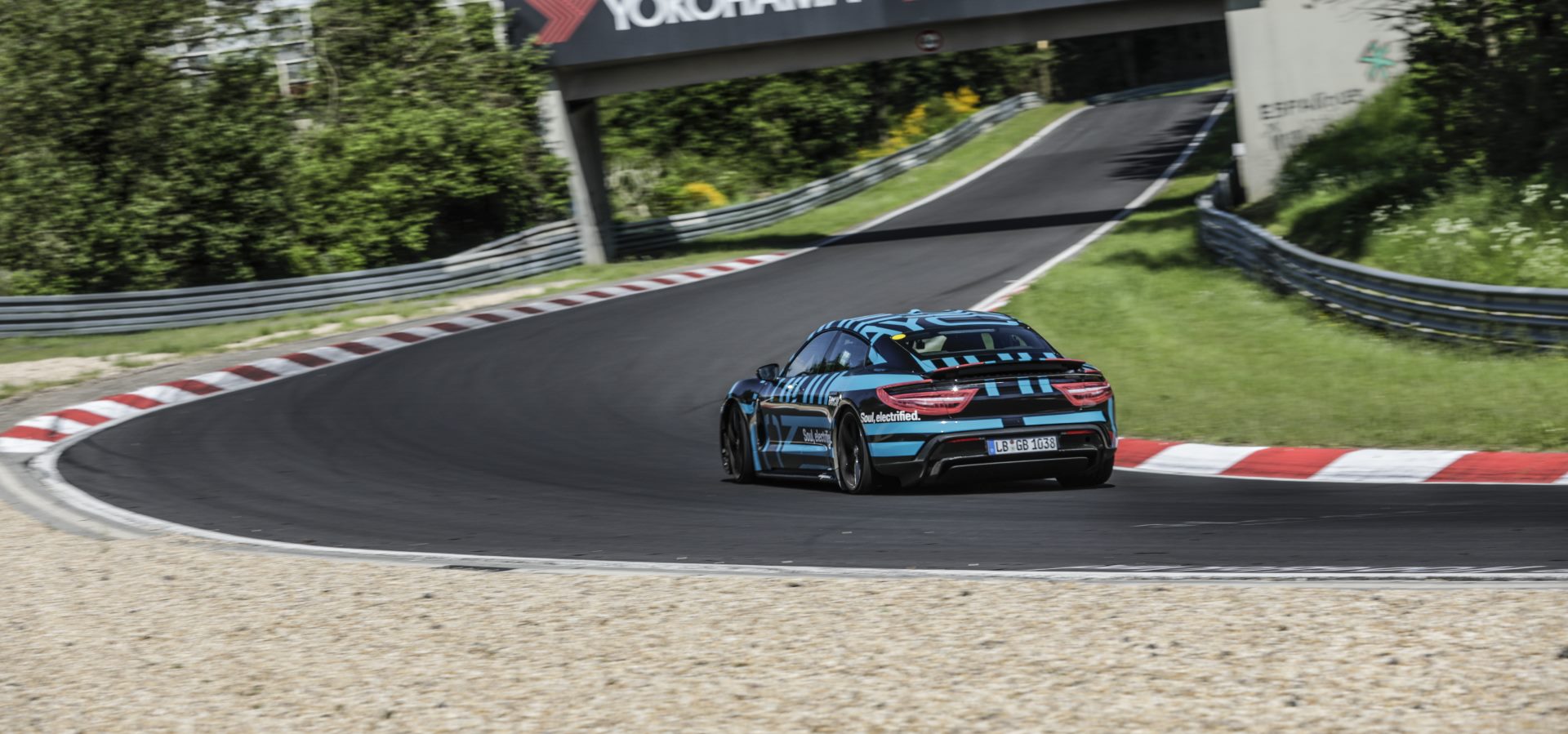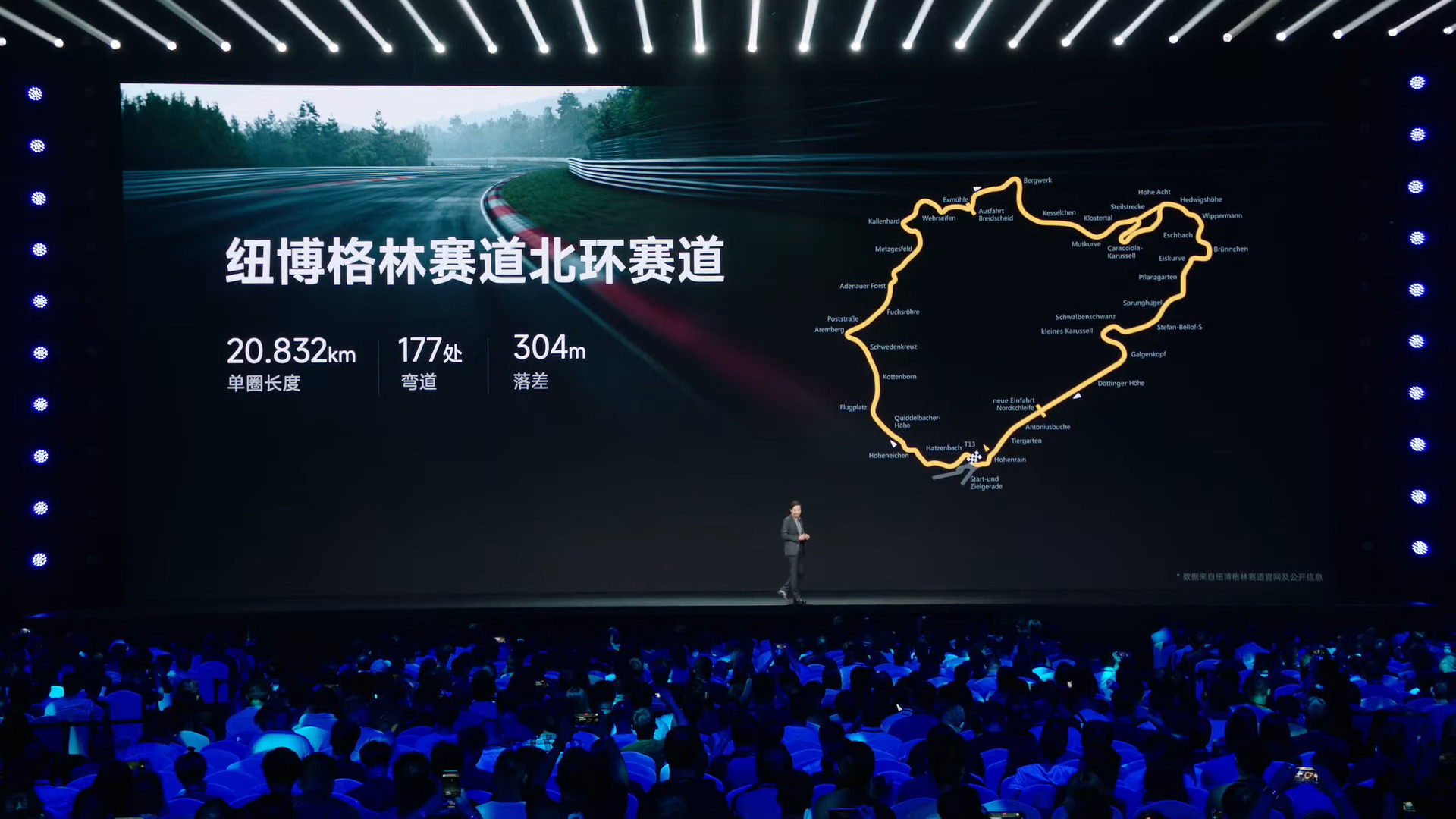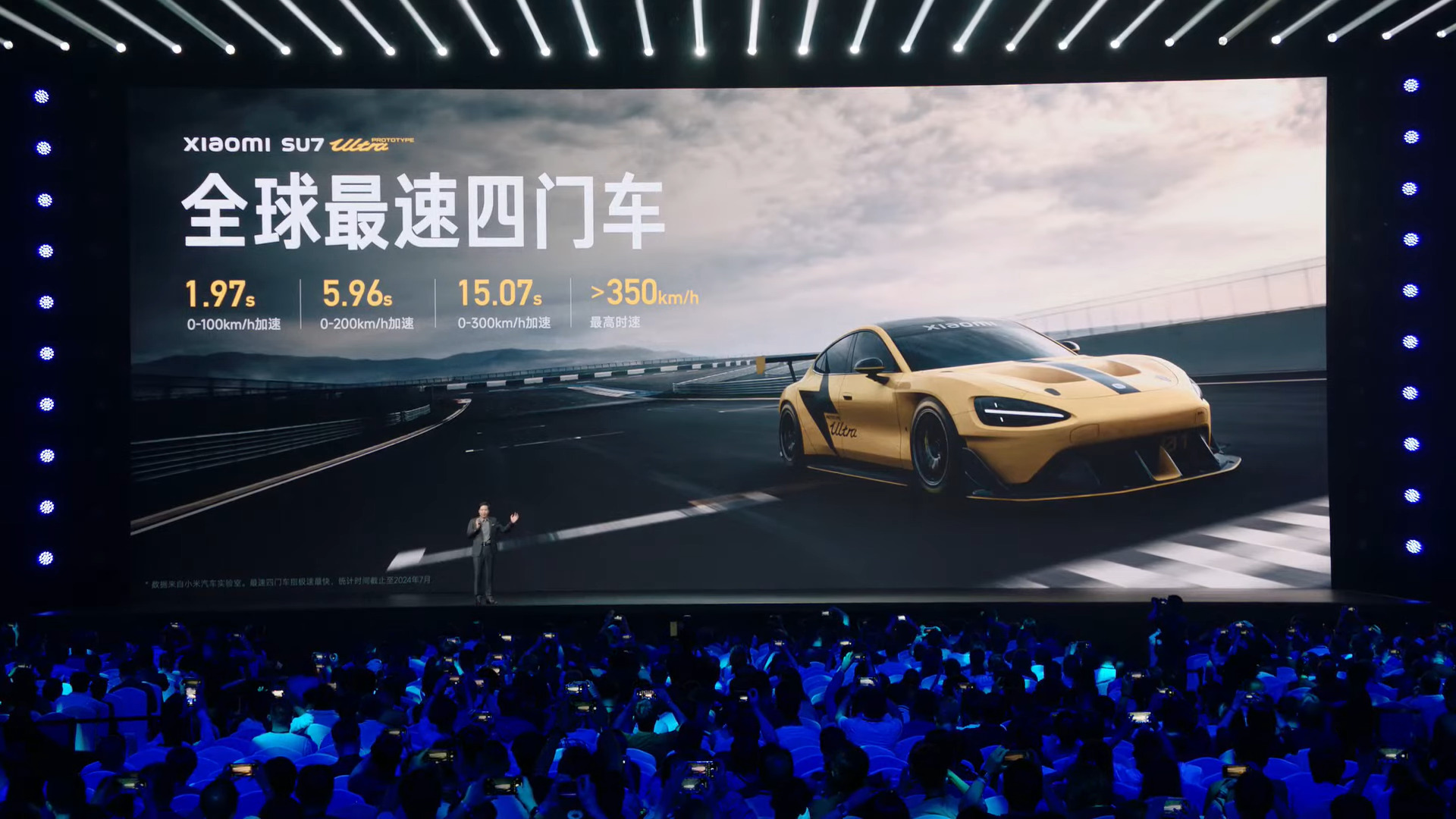Sign up for daily news updates from CleanTechnica on email. Or follow us on Google News!
Just three months after announcing its SU7 Ultra Prototype track-special race car, Xiaomi — best known for its smartphones — has stunned the automotive world by setting an extremely fast lap time at the famous Nürburgring Nordschleife. The Xiaomi SU7 Ultra Prototype completed the lap in just 6 minutes and 46.87 seconds.
The news of the Prototype’s impressive lap time was released to coincide with the commercial launch of the Xiaomi SU7 Ultra retail version on October 29th (see below image). Following standard versions of the Xiaomi SU7 which launched in March (and undercut the price of the Tesla Model 3), the retail version of the extreme high performance Xiaomi SU7 Ultra is now on sale in China, priced from RMB 814,900 (105,546€, $114,237).

While the press release makes clear that the headline lap time was set by a unique race-prepped lightweight prototype variant, there was some controversy in the marketing materials (e.g. the accompanying video) due to the claim that this is “the fastest four-door car in Nürburgring Nordschleife history”. This phrase seemed, on the contrary, to imply that the timed car is some kind of series-production sedan, whereas it is obviously a niche track-special prototype that cannot be directly compared to a 4 door serial-production roadgoing sedan.
Having said that, the retail variant of the Xiaomi SU7 Ultra does share much of the same powertrain with the track-focused prototype, including the same maximum power output. How much power is that? A staggering 1,548 PS, or 1,139 kW!
For context, the Xiaomi SU7 Ultra’s most direct four-door EV rivals are the Porsche Taycan Turbo GT, with a maximum power of 1,033 PS (760 kW), and the Tesla Model S Plaid, with a maximum of 1,035 PS (761 kW).
Neither Porsche nor Tesla have formally released lap times (nor videos) for track-dedicated prototype versions of their current flagship EVs, so we can only speculate about whether similar track-focused prototypes of the road-going sedans from Porsche and Tesla would clock similar lap times.
On the other hand, both Porsche and Tesla have released official lap times of their retail cars, something which Xiaomi only plans to do in 2025, recently saying in its press release “the mass-produced [retail] version of Xiaomi SU7 Ultra will also challenge the Nürburgring Nordschleife next year.” (Xiaomi press release).
Given that race-focused prototypes are a different species of vehicle compared to a retail series production car, a direct comparison of the Xiaomi SU7 Ultra Prototype’s lap time to those of the retail versions of the Porsche and Tesla is somewhat like comparing apples to oranges. Keeping that caveat in mind, let’s take a look at some data points, to at least understand a bit of context within which to situate this Xiaomi lap time.
History of Nordschleife EV Production Car Lap Times
Porsche was the first to publicise an official lap time for the retail version of an EV sports car, with theTaycan, back in August 2019, just prior to the vehicle’s retail launch. The Taycan recorded a time of 7 minutes and 42 seconds (on the 20.6 km track). Porsche said the timed car was close to the retail version, with a few safety modifications. This set a strong benchmark, close to the lap time of the then flagship Porsche Panamera combustion 4-door super saloon (7:38).
Following the Taycan’s publicised time, observers were wondering what Tesla would do in response. In the development phase of the Tesla Model S Plaid in late 2019, Tesla did test out two highly customised prototype variants of the Plaid on the Nordschleife, which we reported on at that time. While Tesla did not publicise formal lap times for those highly modified prototypes, Auto Motor und Sport, the respected German auto magazine, informally clocked a lap time of 7 minutes and 13 seconds for one of them.
Around two years later, in September 2021, Tesla — in collaboration with the Nürburgring’s own official timings — publicised a lap time for an unmodified, retail version of the Tesla Model S Plaid, at 7 minutes and 35.58 seconds (for the 20.8 km track). The 20.6 km equivalent time (to match the Taycan’s earlier lap) was 7:30.91. The retail Tesla Model S Plaid’s lap time thus one-upped the retail Porsche Taycan’s 2019 equivalent time of 7:42.
With the competition thus formally underway, Porsche responded in August 2022 with a slightly faster time of 7 minutes and 33 seconds (now on the 20.8 km track), with a serial production retail Taycan Turbo S, albeit fitted with the optional “new performance kit and Porsche Dynamic Chassis Control (PDCC)”.
Less than a year later, in June 2023, the latest version of the retail Tesla Model S Plaid replied, with a time of 7:25.23, which Nürburgring officials recorded (and notarised) as “a new official time for electric production vehicles.”
Some 7 months later, in January 2024, Porsche lapped a pre-production version of the second generation Porsche Taycan — now in the more powerful Taycan Turbo GT version. The new Taycan recorded a lap time of 7:07.55, convincingly beating the Tesla’s Model S Plaid’s lap from half a year earlier.
The Nürbrugring’s official records currently list the Taycan Turbo GT’s 7.07.55 lap as “the current best time for production electric cars and makes the Turbo GT the fastest four-door car in the Eifel [the Nordschleife circuit’s locale] regardless of the drive system” (emphasis added). This is obviously a win for EVs.
Tesla would likely need to radically overhaul the current Model S Plaid (if not re-engineer it in a second generation Plaid) in order to take the lead back from Porsche.
Prototype vs Stock Production Vehicle
The above lap time history is clearly applicable to stock production vehicles that consumers can buy at retail, albeit with the timed cars having some basic safety modifications (like installation of a roll cage) that the Nürburgring authorities mandate for lap record attempts.
The engineering compromises involved in a production vehicle which sells at high volume to retail customers, typically with a 3-year (or more) warranty, are very different from the choices made when designing a race-going prototype vehicle. The latter can be lighter, more highly stressed, dispense with concerns about reliability, and delete expected safety features (like traction control and air bags), and even practicalities like having 4 comfortable seats, air-conditioning, a stereo, and reasonable noise levels.
Typically — even if based on the underpinnings of a retail production vehicle — a race-prepped prototype can disregard all those comfort and safety concerns, and lose a lot of weight in the process. It can also install more race-biassed suspension and brake components designed purely for performance, laughing in the face of warranties or reliability. Cooling systems can be beefed up, yet also lightened.
Even with the same power output, lightweighting can make a huge difference to lap times. The race-prepped Porsche 911 GT2 RS clubsport is some 15 seconds faster than the retail road car. In the case of the Mclaren P1 GTR, the difference with the retail road car is about 20 seconds.
Beyond weight saving, tire choice can have a huge impact on lap times. A typical road-biased sport tire (Michelin PS5, Pirelli PZ4) is designed for predictable performance in both wet and dry conditions, in both cold and warm temperatures, and to be reasonably durable for daily use. By contrast, track-focussed tires (Michelin PS Cup 2 R, PIrelli PZ Trofeo R) are made from much softer and stickier rubber compounds, which give much more grip in corners and for traction, but are not nearly as durable. These track-focused tires alone can improve a Nordschleife lap time by roughly 10 to 20 seconds over the aforementioned road-biased tires, depending on the car and conditions.
Going further still, a track-focused slick tire with smooth rubber surface can offer even more grip than a tire with grooves, stipes and channels which are normal on road cars. These features are designed to displace surface water from a road and provide safe and predictable grip in a wide variety of weather conditions. Slick tires, by contrast, only work predictably in dry conditions, and can dramatically lose grip on a patch of wet road, and are thus not typically road-legal. Compared to road-biased “sport” tires, racing slicks can potentially improve a Nordschleife lap time by 30 seconds or more (in the right conditions).
Coming back to this specific case, the Xiaomi SU7 Ultra Prototype that recorded the publicised lap time of 6:46.87 did use slick tires, but — with its opportunity to go for a record lap being foreshortened for various reasons — this lap was actually made in somewhat wet conditions. So the ostensible advantage of slack tires is in fact a moot point in this particular case.
As for the light-weighting aspect — the prototype reportedly shed a lot of kg compared to the retail version, coming in at 1900 kg (see our previous report for more specs), which could be as much as 300 kg less than the retail version. For context, the retail Tesla Model S Plaid “track package” is 2162 kg, and the Porsche Tycan Turbo GT (“Weissach package”) is 2234 kg. The retail Xiaomi SU7 Ultra is likely to be in that ~2200 kg ballpark also (as is the SU7 “Max” variant) . Xiaomi boss, Lei Jun, has already said that the retail version will not have nearly as much carbon-fibre as the prototype version, as that would be cost prohibitive.
Finally in regard to substantive engineering difference, as can be seen in the above image, the prototype also has particular aerodynamic components, which give it a massive downforce of 2,145 kg at high speeds, putting it in the realm of dedicated track-cars.
By contrast, Xiaomi’s press release for the retail SU7 Ultra only mentions 285 kg of downforce at high speed — a world apart. Most of the retail version’s owners will still be looking for decent efficiency in daily use (rather than drag-inducing huge wings), and also because road-going cars obviously must have “pedestrian-safe” bodywork that track-only cars don’t have to worry about. Here’s a side by side composite image which highlights the aerodynamic differences:
We can see that the front and side skirts are much more extreme in the prototype (left), and the rear wing is significantly larger.
The power levels are said to be the same between the prototype and its retail siblings, and, more importantly, the cooling capacity (which is a significant bottleneck for practical power levels over the long Nordschleife circuit) is described as being similar. But on a twisty circuit, beyond a certain level, power is not nearly as important as the lightweighting and aero factors. In these areas the large differences between the prototype and retail versions will mean that the lap times will be significantly different.
What can we glean from all of this about the likely future lap time of the retail Xiaomi SU7 Ultra, compared to those already seen for the retail Porsche Taycan, and retail Tesla Model S?
One redeeming factor that could help the Xiaomi SU7 — relative to its Porsche and Tesla rivals — is that the SU7 Ultra Prototype’s publicised lap time of 6:46.87 was in fact suboptimal compared to its likely potential. Xiaomi needed to publicise a lap time to coincide with the launch date of the SU7 Ultra retail version (on Tuesday October 29th).
So the 6:46.87 lap time is in fact only the best time recorded so far. As can be seen from the video (below), the track conditions were wet and damp, and thus there is still plenty of room for improvement. The damp conditions may have cost 10+ seconds of potential lap time.
Additionally, as can be seen at the 4 mins 15 second mark, the accelerator pedal was temporarily unresponsive for around 15 seconds (rumoured to be due to leaves interfering with wheel speed sensors). This temporary glitch likely added another 3 or 4 seconds to the lap time.
Altogether, in better conditions and with more setup work, the lap time of the prototype could perhaps be improved to around 6:30 (as at least one experienced Nordschleife racer estimates it). Even if the retail version ends up recording a 2025 lap time some 40 seconds slower, this could still put it at around 7:10 – not far from the lap time of the retail Porsche Taycan Turbo GT (7:07).
Strong Debut
The Porsche Taycan Turbo GT costs from 1,998,000 RMB in China, almost 2.5x the entry cost of the retail Xiaomi SU7 Ultra. From this perspective, this is all pretty impressive considering the SU7 is Xioami’s first ever car, and the entire project – to build a car at all — was only conceived of in January 2021. After all, Porsche has an auto engineering history going back almost 120 years to the Lohner–Porsche Mixte Hybrid of 1901.
We will have to wait until mid to late 2025 to see how the retail version of the Xiaomi SU7 Ultra actually performs on the Nordschleife. For those wondering what relevance Nürburgring lap times have to normal mobility needs, that’s a fair question, but take a look at my exploration of this topic from 2019.
What are your predictions for the map time of the retail Xiaomi SU7 Ultra? Is 7:10 too optimistic for 2025? How should Porsche and Tesla respond? Share your thoughts in the comments section below.
Article images courtesy of respective brands.

Chip in a few dollars a month to help support independent cleantech coverage that helps to accelerate the cleantech revolution!
Have a tip for CleanTechnica? Want to advertise? Want to suggest a guest for our CleanTech Talk podcast? Contact us here.
Sign up for our daily newsletter for 15 new cleantech stories a day. Or sign up for our weekly one if daily is too frequent.
CleanTechnica uses affiliate links. See our policy here.
CleanTechnica’s Comment Policy







